Displaying items by tag: Sweboat
New Energy for Irish Marine Trade At Southampton Boat Show
Did Southampton Boat Show 2015 that ended yesterday mark the end of the recession for the Irish Marine trade? That depends on who you talk to but if numbers are any evidence to go by there was plenty more Irish faces among the 110,000 that enjoyed a taste of Britain’s biggest boating festival.
Irish show-goers made good use of the Flybe connections from Dublin and the sprinkling of Irish marine firms among the 500 exhibitors gave a great sense of pre-recessionary times.
Mid–week wet weather may have dragged down attendance numbers but it failed to dampen the mood at this year’s Show.
Trade bodies made good use of the opportunity for a useful 'heads-up' on numerous industry matters too. The Society of Maritime Industries, British Marine and the UK Chamber of Shipping signed a Memorandum of Understanding (MOU) to set out the basis for all three to work together.
On an international footing, there was a consensus that better promotional co-operation between member states could increase participation levels in EU boating. The recently rebranded British Marine Federation (now known as 'British Marine') are certainly doing their bit. Murray Ellis, Managing Director, British Marine Boat Shows said: “We have had yet another incredibly successful Southampton Boat Show with more than 10,000 visitors getting out on the water for free. Our attractions have been very popular this year with over 18,000 visits to our tall ship, the Earl of Pembroke, 5,300 rides on the Honda Boat Show Eye and over 27,000 visitors to the Show’s very own Aquarium.
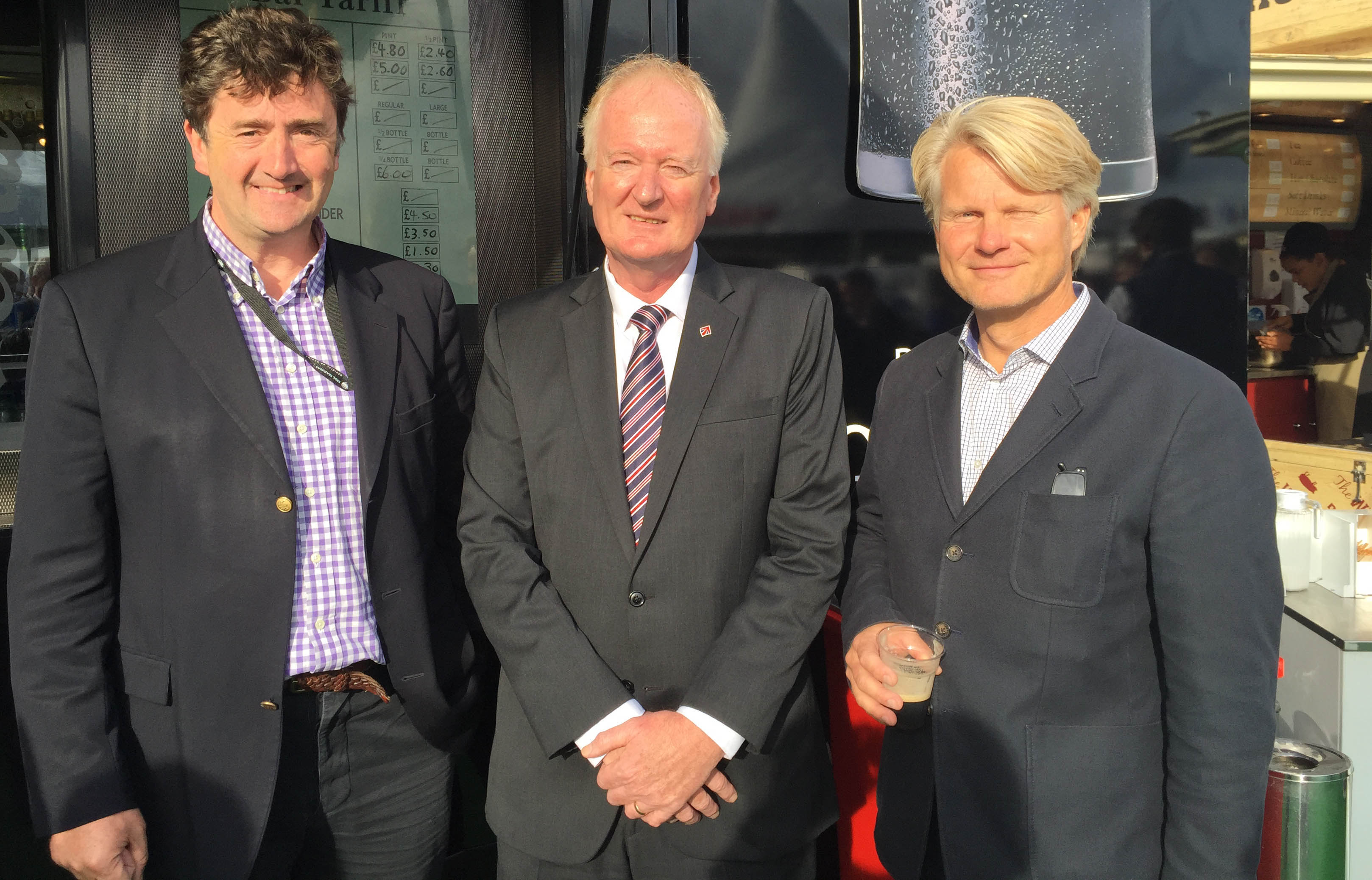
Pride of place for Irish stands at Southampton went to the impressive MGM Boats brokerage stand excellently located at the top of the ramp to the show marina. It was an impressive display of boats using the latest digital screens to display boats specs and prices.
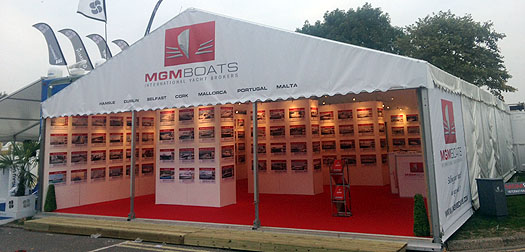
The MGM Brokerage stand - the venue for boat sales as well as the Ireland v Canada Rugby match last Saturday
The stand had over €60m of boat stock on display and the full MGM boats crew headed by Martin and Gerry Salmon were kept busy with 'quality enquiries' for their used sail and power range. The Salmon brothers were joined by John O'Kane, Ross O'Leary, Alan Barton and John McDonald and the company's presence was noted on Sunseeker, Galeon, Aquador, Lagoon, Jeanneau and Prestige stands.
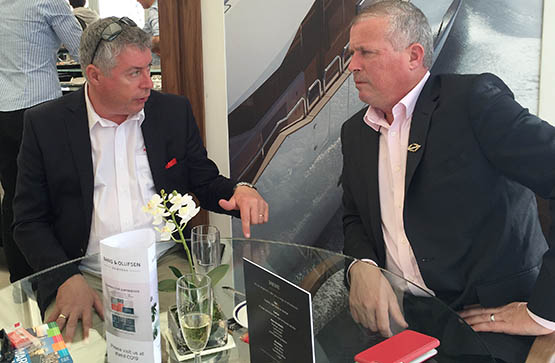
Martin (left) and Gerry Salmon discuss new boat deals at the Sunseeker stand
The Show saw 23 boats make their world debut and over 330 of the world's leading sailboats and high-performance powerboats on the water.
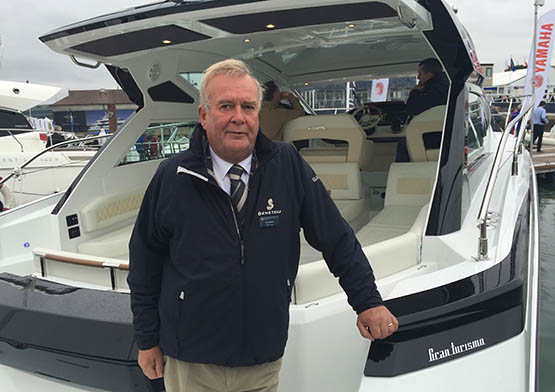
Alan Corr from BJ Marine in Greystones in County Wicklow was on Beneteau's new GT 40 from Beneteau
Strong sales have been reported throughout the duration of the Show, with many companies reporting an increase on last year’s figures including multi-million pound deals. Some serious marine business has been conducted with contracts between the marine divisions of companies such as Rolls-Royce and Sunseeker International being signed.
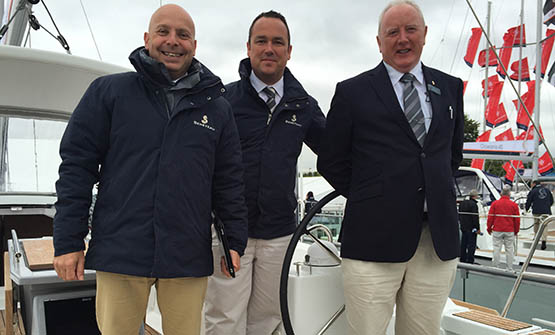
Mike Caplan (left), James Kirwan (centre) and Bernard Gallagher from BJ Marine on a new Oceanis 48 (show price £223,038) that will be coming to Dublin next season
'We have been delighted with our two weeks of boat shows in first Cannes and then Southampton. We secured deals for all offices, Greystones, Bangor, Pwllheli and Malta. Clients have been extremely interested in the price point of our new Beneteau GT 40, Fountaine Pajot's Saba 50 catamaran and Sea Ray's European built 355 Sundancer', James Kirwan of BJ Marine told Afloat.ie

Dufour's new 500 Grand Large was exhibited at Southampton by Cork Harbour's Hugh Mockler of Crosshaven Boatyard
Hugh Mockler of Crosshaven Boatyard was on board the Dufour 500 Grand Large. Mockler was imprerssed with the good turnout as well as a number of interested Irish parties in the new line–up. The Dufour 382 Grand Large was also afloat at the show. Crosshaven Boatyard was tweeting from the show about a new concept boat called the with a lifting keel designed for sailing schools. The brand new Dufour Drakkar 24 (below) is designed by Umberto Felci and it was unveiled at the French Grand Pavois, Boat Show in La Rochelle next week.
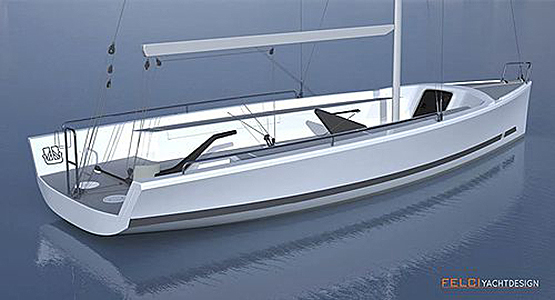
Debbie Weldon and Dick Fanning from Howth were onboard both of X Yachts Xc 38 and Xc 45 models. Fanning says yhe Xc 38 is the model that offers superb performance in an easily handled package and is ideal for doublehanded sailing. This model was the second yacht in the Xcruising range to be named European Yacht of the Year in the Luxury Cruiser category, on its launch.
Ronan Beirne of Leinster Boats of Dun Laoghaire said his Euro priced boat brokerage list was well received at the show. Several new enquiries were logged for vessel inspections in the coming weeks.
Bobby Nash of Kinsale was exhibiting his range of 3D Nautical charts displaying a selection from the British Isles, the Mediterranean and the Pacific. County Antrim based Red Bay Boats were also displaying their acclaimed range of Ribs. Both Gary Fyffe and Tom McLaughlin from the Cushendall firm were in attendance at the show.

Howth's Debbie Weldon (above) on the Danish built Xc38 and Dick Fanning (below) on the Xc45 from X–Yachts
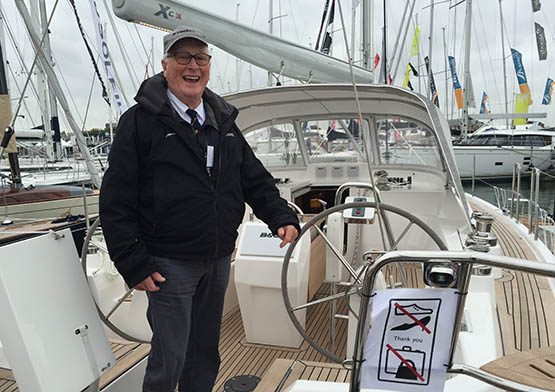
A number of key Irish ports and marinas were also promoting their wares. Aoife McHale was on hand at the Visit Derry stand continuing the promotion of Northern Ireland's maritime assets on Lough Foyle. McHale explained the city is also gearing up to welcoming the return of the Clipper Round the world race next year to the Malin coast.
Irish Sea interests were promoted by British Marine Wales where Ireland is seen as a key market.
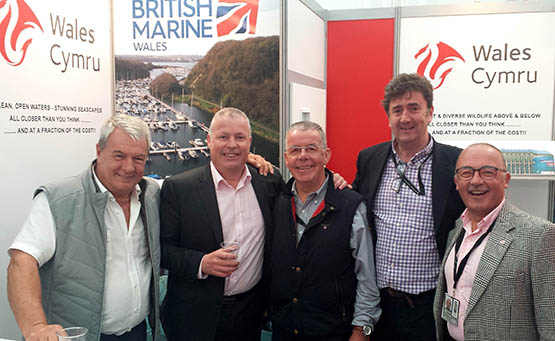
David Reed of Visit Wales, Gerry Salmon of MGM Boats, Alan Morgan of British Marine Wales, David O'Brien of the Irish Marine Federation and David Pougher of British Marine Wales




























































